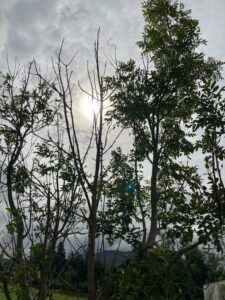Ashdieback
Ashdieback is scientifically known as Hymenoscyphus Fraxineus (formerly known as Chalara fraxinea). It was first discovered in Ireland in October 2012. The disease was Initially identified in County Leitrim and County Tipperary. It is believed that the disease was introduced to Europe through the importation of infected ash tree or wood products. Once in Europe it spread quickly affecting all countries. The first confirmed case in Europe was Poland in the early 1990s and it gradually spread to other European countries and eventually arrived in Ireland. Ash dieback can spread via airborne spores making it highly contagious and hard ton control.
There is roughly 17,000 hectares of ash in Ireland which was all infected by ash dieback. Since then, it has spread all over the country and is a major problem which has affected all ash plantations and ash trees in hedgerows all over the country.
The ashdieback has significance importance in Ireland due to invaluable resources contributing to the production of timber, furniture making and hurley butts which are used for hurls. Ash trees also have a vital role in the environment for local wildlife and is now impacting our ecosystem.
Signs of ash dieback are easy to spot during the summer months when the trees should be in full leaf. Ash trees infected will have a lack of leaves in summer months, key signs of dieback are spots on the leaves with dark or brown spots on the leaves. The leaves will start to wilt. The crown of the tree will become very bear with some branches without any leaves. During the summer months ash dieback can cause spots on the trees/ branches causing the tree to shed leaves early in the year. Dark patches on the trees are called lesions they can appear on the bark of the tree or at the base of the tree.
It can be seen in the trunk of the tree when its being harvested, there will be a small black distinctive spot inside the tree. Branches on the tree become very brittle and dangerous. During storms branches or even trees can be blown over which makes it very dangerous.
In response to the ash dieback crisis the government has launched the Ash Dieback Reconstitution Scheme. The scheme was introduced to provide support for landowners affected by ash dieback disease, in particular landowners with commercial forest of ash. Key components of the ash dieback disease scheme include financial assistance, species replacement and diversification.
To enter the ash reconstitution, scheme a landowner must contact their local forester to submit an application. The Forster will conduct a site visit and then submit the application to the department.
Financial support: Under the scheme, affected landowners can get financial support per hectare to remove all ash trees on site, also grants are in place for the replanting of the same area with other broadleaves or Sitka spruce. Replanting of ash is not aloud. This support is critical in ensuring the economic sustainability of affected forests.
Species replacement: All species of trees are acceptable, new species planted will enhance ecological diversity in the site and reduce risk of future disease and outbreaks.
The timber from ash plots will be used for firewood or hurley butts. Ash makes great firewood. The landowner owns all the timber and its their decision whether to sell the timber or keep it for themselves.
Diversification and future planning, the ash dieback scheme encourages landowners to diversify more than using just commercial trees like spruce, with a mix of tree species, by having this approach It will help fight new diseases but also improve the long-term health and biodiversity or Irish woodlands which is very important.
For further details please contact us at
www.ForestryServices.ie www.Ashdieback.ie www.Euroforestireland.ie


